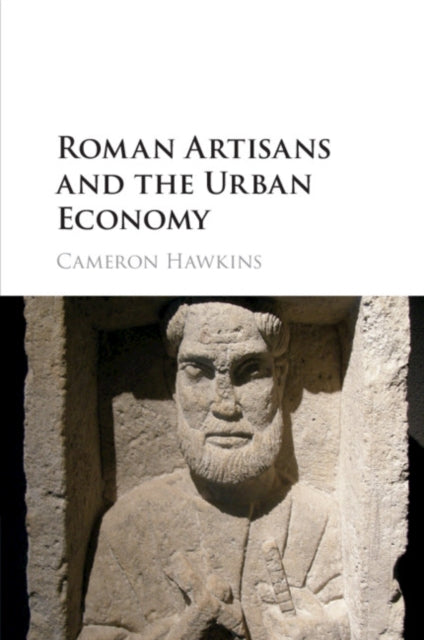Cameron Hawkins
Roman Artisans and the Urban Economy
Roman Artisans and the Urban Economy
YOU SAVE £1.54
- Condition: Brand new
- UK Delivery times: Usually arrives within 2 - 3 working days
- UK Shipping: Fee starts at £2.39. Subject to product weight & dimension
Bulk ordering. Want 15 or more copies? Get a personalised quote and bigger discounts. Learn more about bulk orders.
Couldn't load pickup availability
- More about Roman Artisans and the Urban Economy
This book provides a comprehensive study of economic conditions and economic life in Roman cities during the late Republic and early Empire, using comparative evidence and contemporary economic theory to argue about the relationship between consumer demand, labor markets, artisans, and economic growth. It will interest specialists in economic history and discuss topics such as slavery, professional associations, and gender.
Format: Paperback / softback
Length: 319 pages
Publication date: 22 July 2021
Publisher: Cambridge University Press
This book is a groundbreaking exploration of the economic conditions and economic life in Roman cities during the late Republic and early Empire. Through a rigorous methodology rooted in comparative evidence and contemporary economic theory, the author presents a comprehensive analysis of four crucial aspects of urban economic life in Roman antiquity: the nature and magnitude of consumer demand, the structure of urban labor markets, the strategies employed by urban artisans to navigate their social and economic environments, and the factors that hindered the overall performance and potential for intensive growth of the Roman economy. While the author's approach and findings will be of particular interest to experts in economic history, this book also offers valuable insights to a broader audience, covering topics such as slavery and manumission, the economic significance of professional associations, and the influence of gender on economic behavior.
The book begins by examining the nature and magnitude of consumer demand in Roman cities. The author argues that consumer demand was a key driver of economic growth and development in Roman antiquity. The Roman population was vast, and the demand for goods and services was constantly expanding. This led to the development of a sophisticated market system, with merchants and traders operating across a wide range of goods and services.
The author then explores the structure of urban labor markets in Roman cities. The Roman economy was characterized by a large and diverse workforce, with workers employed in a wide range of industries, including agriculture, manufacturing, and commerce. The labor market was highly competitive, with wages often low and working conditions often harsh. However, the Roman government also implemented policies to protect workers' rights and ensure fair labor practices.
Next, the author examines the strategies devised by urban artisans in their efforts to navigate their social and economic environments. The Roman artisan class was a crucial component of the urban economy, producing a wide range of goods and services. The author argues that artisans were skilled and innovative, and they developed a range of strategies to survive and thrive in their competitive markets. These strategies included forming professional associations, developing networks of suppliers and customers, and adapting to changing market conditions.
Finally, the author explores the factors that served to limit both the overall performance of the Roman economy, and its potential for intensive growth. The Roman economy was characterized by a number of challenges, including political instability, economic inequality, and environmental degradation. These factors contributed to a number of economic problems, including inflation, unemployment, and poverty. However, the Roman government also implemented policies to address these challenges, including the development of public infrastructure, the promotion of trade and commerce, and the implementation of social welfare programs.
In conclusion, this book offers a comprehensive and insightful exploration of the economic conditions and economic life in Roman cities during the late Republic and early Empire. Through a rigorous methodology rooted in comparative evidence and contemporary economic theory, the author presents a rich and detailed analysis of four crucial aspects of urban economic life in Roman antiquity. While the book will be of particular interest to specialists in economic history, it also offers valuable insights to a broader audience, covering topics such as slavery and manumission, the economic significance of professional associations, and the influence of gender on economic behavior. This book is a valuable contribution to our understanding of the economic and social history of Roman antiquity, and it will be of interest to scholars and students of history, economics, and social science alike.
Weight: 476g
Dimension: 152 x 228 x 21 (mm)
ISBN-13: 9781107535732
This item can be found in:
UK and International shipping information
UK and International shipping information
UK Delivery and returns information:
- Delivery within 2 - 3 days when ordering in the UK.
- Shipping fee for UK customers from £2.39. Fully tracked shipping service available.
- Returns policy: Return within 30 days of receipt for full refund.
International deliveries:
Shulph Ink now ships to Australia, Belgium, Canada, France, Germany, Ireland, Italy, India, Luxembourg Saudi Arabia, Singapore, Spain, Netherlands, New Zealand, United Arab Emirates, United States of America.
- Delivery times: within 5 - 10 days for international orders.
- Shipping fee: charges vary for overseas orders. Only tracked services are available for most international orders. Some countries have untracked shipping options.
- Customs charges: If ordering to addresses outside the United Kingdom, you may or may not incur additional customs and duties fees during local delivery.


